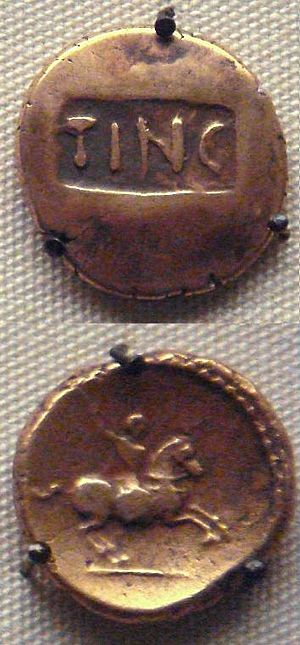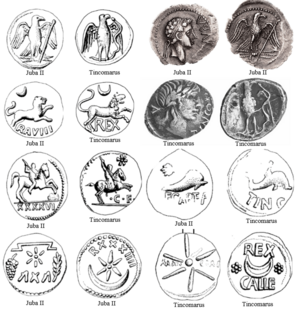Tincomarus facts for kids

Tincomarus was a king of the Iron Age Belgic tribe called the Atrebates. This tribe lived in southern central Britain just before the Roman invasion. His name means something like "big fish" in the old Celtic language. For a long time, people thought his name was "Tincommius" because of old coin writings. But in 1996, new coins were found that showed his full name.
Contents
Who Was King Tincomarus?
Tincomarus was the son of Commius, who was also a king. Tincomarus became king after his father, around 25-20 BC. Some historians think Tincomarus might have ruled alongside his father for a few years before Commius died.
Tincomarus and Rome
Not much is known about Tincomarus's time as king. However, the coins he made tell us a lot. His coins looked much more like Roman coins than his father's did. This suggests he was friendly with the powerful Roman Empire. Some experts even think Roman artists might have helped design his coins. This could mean that the Romans were helping the Atrebates with more than just coins, perhaps with other technologies too.
Later kings who followed Tincomarus used the word rex (which means "king" in Latin) on their coins. This shows that Tincomarus probably started the process of becoming a "client king" of Rome. A client king was a ruler who kept his throne but was friendly with and supported by Rome. You can learn more about this at Roman client kingdoms in Britain.
Was Tincomarus a Diplomatic Hostage?
One idea, from historian John Creighton, is that Tincomarus might have grown up in Rome as an obses. An obses was a special kind of diplomatic hostage. This means he would have been sent to Rome by his father to show loyalty and ensure peace. While in Rome, he would have been treated well and learned about Roman ways.
Creighton noticed that Tincomarus's coins had similar pictures to those of Juba II, another king from Numidia (a region in North Africa). Juba II was known to have been an obses in Rome. A coin found in Numidia might even have the name of Tincomarus's younger brother, Verica, on it. This connection makes the idea of Tincomarus being an obses more likely.
Trade and Diplomacy with Rome
By 16 BC, many Roman goods, like pottery, started appearing in Tincomarus's capital city, Calleva Atrebatum. Today, this place is known as Silchester. This suggests that Tincomarus had set up important trading and diplomatic connections with the Roman Emperor Augustus.
End of His Reign
Around AD 8, Tincomarus was forced to leave his kingdom by his own people. We don't know exactly why this happened. He fled to Rome, asking for help and protection. His brother, Eppillus, took his place as king. Emperor Augustus chose to recognize Eppillus as the new king instead of helping Tincomarus get his throne back. Augustus might have thought about using Tincomarus's situation as an excuse to invade Britain, but other important problems probably made him wait.


